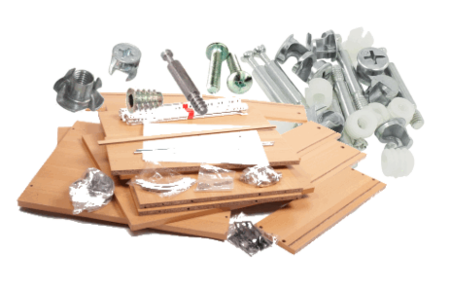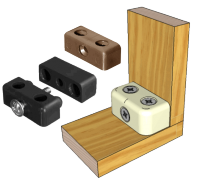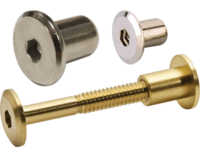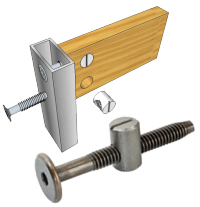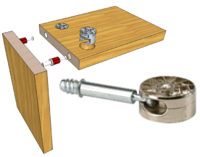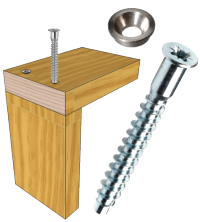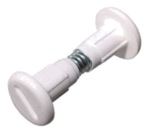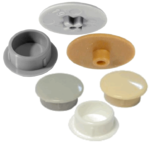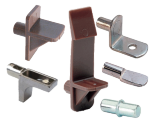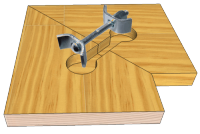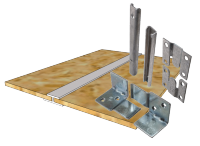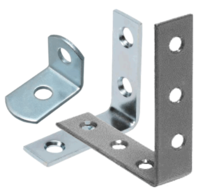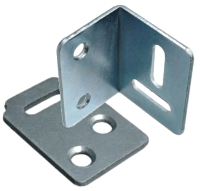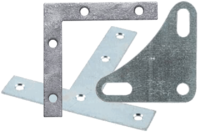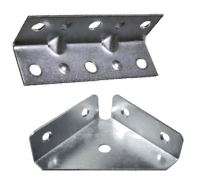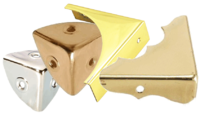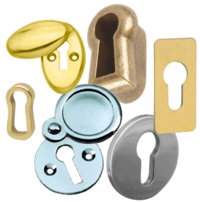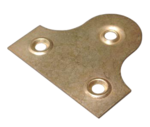Knock Down Fittings, Brackets and Plates: Difference between revisions
From DT Online
mNo edit summary |
m (Added Amazon Link) |
||
| (11 intermediate revisions by the same user not shown) | |||
| Line 1: | Line 1: | ||
<div class="floatright"><dtamazon type="search" search="Knock Down Fittings"><img alt="FlatPackFittings.png" src="/images/thumb/8/8c/FlatPackFittings.png/450px-FlatPackFittings.png" width="450" height="288" srcset="/images/8/8c/FlatPackFittings.png 1.5x, /images/8/8c/FlatPackFittings.png 2x" /></a></dtamazon></div> | |||
__TOC__ | |||
Screw and bolt type KD Fittings, which pull the joint together, are often supplemented by use of | =====Description===== | ||
[https://en.wikipedia.org/wiki/Ready-to-assemble_furniture '''Flat Pack''', '''Ready to Assemble(RTA)''' or '''Knock Down(KD)''' Furniture] is commonly constructed from sheets of [https://en.wikipedia.org/wiki/Particle_board '''Particle Board'''] which are '''[[Butt Joint|Butt Jointed]]''' together and held in place by a variety of mechanical fittings - known generally as [https://en.wikipedia.org/wiki/Butt_joint#Knock-down_fasteners '''Knock Down'''] or [https://en.wikipedia.org/wiki/Butt_joint#Knock-down_fasteners '''KD Fittings''']. | |||
Screw and bolt type KD Fittings, which pull the joint together, are often supplemented by use of '''[[Dowel|dowels]]''' to provide added location. | |||
In addition, various brackets and braces are also used to strengthen or protect edges and corners of other products, especially those made from thin sheet materials, and repair plates are available, which are shaped and drilled to reinforce loose joints by being screwed across them. | In addition, various brackets and braces are also used to strengthen or protect edges and corners of other products, especially those made from thin sheet materials, and repair plates are available, which are shaped and drilled to reinforce loose joints by being screwed across them. | ||
=====Knock Down (KD) Fittings===== | |||
{| | {| | ||
| Line 20: | Line 27: | ||
|- | |- | ||
| [https://en.wikipedia.org/wiki/Dowel#In_woodworking '''Cross Dowels'''] | | [https://en.wikipedia.org/wiki/Dowel#In_woodworking '''Cross Dowels'''] | ||
| Also known as ' | | Also known as '''‘Barrel Nuts’''' these are designed for use with Joint Connector Bolts where a right angle connection is needed. | ||
| [[File:CrossDowels.png|200px|right]] | | [[File:CrossDowels.png|200px|right]] | ||
|- | |- | ||
| Line 30: | Line 37: | ||
| Also known as '''‘Confirmat Screws’''' these are used for easy assembly and dismantling of carcase sections, especially in Particle Board. The deep cutting thread helps to ensure accurate and close-fitting joints. | | Also known as '''‘Confirmat Screws’''' these are used for easy assembly and dismantling of carcase sections, especially in Particle Board. The deep cutting thread helps to ensure accurate and close-fitting joints. | ||
| [[File:FurnitureScrews.png|200px|right]] | | [[File:FurnitureScrews.png|200px|right]] | ||
|- | |||
| [http://www.example.com '''Cabinet Connector Screw'''] | |||
| Similar to Furniture Connector Nuts and Bolts but with a capacity limited to 30mm-39mm, these are commonly used to join flat pack Kitchen Units, Wardrobes, or Cupboards together. They are usually set into the front row of unused shelf peg holes and when tightened, keep units in line and spread any uneven load. | |||
| [[File:CabinetConnectorScrew.png |150px|right]] | |||
|- | |||
| '''Cover Caps''' | |||
| Made of plastics in a range of colours, these are available in a variety of sizes and designs and used to conceal unused holes or to hide screw heads from view for example. | |||
| [[File:CoverCaps.png|150px|right]] | |||
|- | |||
| '''Shelf Supports''' | |||
| Available in plastic or steel, these plug into 5 mm diameter holes - a series of holes can be drilled equally spaced vertically for adjustable shelves. A shelf with 4 supports will typically carry a distributed load of 80kg to 100kg. | |||
| [[File:ShelfSupports.png|150px|right]] | |||
|- | |- | ||
| [http://www.example.com '''Worktop Connector Bolts'''] | | [http://www.example.com '''Worktop Connector Bolts'''] | ||
| Designed to provide a strong neat join between kitchen worktops | | Designed to provide a strong neat join between kitchen worktops. The nut is tightened onto the bolt pressing the caps against the walls of 35 mm diameter 'blind' holes drilled into the underside. This pulls the two worktop sections tightly together | ||
| [[File:WorktopConnectionBolt.png|200px|right]] | | [[File:WorktopConnectionBolt.png|200px|right]] | ||
|} | |||
{{KD Fittings Buyers Guide}} | |||
=====Brackets and Plates===== | |||
{| | |||
|- | |||
| '''Panel Connectors''' | |||
| Panel Connector Strips are commonly used in Flat Pack furniture to join together the laminated '''[[Manufactured Board|MDF]]''' used to make backs of cabinets and wardrobes. In addition, various designs of surface mounted panel connectors are used to fasten thicker panels without glue or '''[[Dowel|dowels]]'''. Flush Mount connectors can join panels edge to edge or at a right angle and Tapered Connectors are often used on the back of header boards to mount them on display stands for example. | |||
| [[File:PanelConnectors.png|200px|right]] | |||
|- | |- | ||
| '''Angle Brackets''' | | '''Angle Brackets''' | ||
| Line 56: | Line 85: | ||
|- | |- | ||
| [https://en.wikipedia.org/wiki/Escutcheon_%28furniture%29 '''Escutcheon'''] | | [https://en.wikipedia.org/wiki/Escutcheon_%28furniture%29 '''Escutcheon'''] | ||
| This term derives from an old French word for shield and is most commonly used to describe the plate or insert surrounding keyholes in doors, cabinets, desk drawers or chests. | | This term derives from an old French word for [https://en.wikipedia.org/wiki/Escutcheon_(heraldry) shield ''(escusson)''] and is most commonly used to describe the plate or insert surrounding keyholes in doors, cabinets, desk drawers or chests. | ||
| [[File:Escutcheons.png|200px|right]] | | [[File:Escutcheons.png|200px|right]] | ||
|- | |- | ||
| | | '''Mirror Plates''' | ||
| These screw to the back of a picture frame or mirror frame to | | These screw to the back of a picture frame or mirror frame to provide a means of hanging them on to a wall. They can also be used for hanging bookshelf units and other cabinets for example. | ||
| [[File:MirrorPlate.png| | | [[File:MirrorPlate.png|150px|right]] | ||
|} | |} | ||
{{Brackets and Braces Buyers Guide}} | |||
[[Category:Fixings and Fastenings]] | [[Category:Fixings and Fastenings]] | ||
Latest revision as of 13:52, 7 November 2017
Description
Flat Pack, Ready to Assemble(RTA) or Knock Down(KD) Furniture is commonly constructed from sheets of Particle Board which are Butt Jointed together and held in place by a variety of mechanical fittings - known generally as Knock Down or KD Fittings.
Screw and bolt type KD Fittings, which pull the joint together, are often supplemented by use of dowels to provide added location.
In addition, various brackets and braces are also used to strengthen or protect edges and corners of other products, especially those made from thin sheet materials, and repair plates are available, which are shaped and drilled to reinforce loose joints by being screwed across them.
Knock Down (KD) Fittings
| Connecting Blocks | Made from Polyethylene and commonly available in dark brown or white, these are used for joining sheet materials and attaching kitchen units to the underside of the worktop for example. They are also known as ‘Modesty Blocks’ because In the 1960's, when open plan offices became popular, they were used to add a panel between desk pedestals. Two-part blocks bolt together and so enable dismantling. | |
| Furniture Connector Nuts and Bolts | Typical applications include cabinets, chairs, desks, shop equipment and tables. Furniture Connector Bolts are for use with Joint Connector Nuts or Cross Dowels. They are designed for use with self-assembly furniture, and are easily applied with an Allen key. | |
| Cross Dowels | Also known as ‘Barrel Nuts’ these are designed for use with Joint Connector Bolts where a right angle connection is needed. | |
| CamLock Fitting | Cam and Dowel fittings are commonly used to assemble flat pack furniture and kitchen cabinets. Cam and Dowel parts are used to pull together standard thickness board panels to give a hidden fixing. | |
| Furniture Connector Screws | Also known as ‘Confirmat Screws’ these are used for easy assembly and dismantling of carcase sections, especially in Particle Board. The deep cutting thread helps to ensure accurate and close-fitting joints. | |
| Cabinet Connector Screw | Similar to Furniture Connector Nuts and Bolts but with a capacity limited to 30mm-39mm, these are commonly used to join flat pack Kitchen Units, Wardrobes, or Cupboards together. They are usually set into the front row of unused shelf peg holes and when tightened, keep units in line and spread any uneven load. | |
| Cover Caps | Made of plastics in a range of colours, these are available in a variety of sizes and designs and used to conceal unused holes or to hide screw heads from view for example. | |
| Shelf Supports | Available in plastic or steel, these plug into 5 mm diameter holes - a series of holes can be drilled equally spaced vertically for adjustable shelves. A shelf with 4 supports will typically carry a distributed load of 80kg to 100kg. | |
| Worktop Connector Bolts | Designed to provide a strong neat join between kitchen worktops. The nut is tightened onto the bolt pressing the caps against the walls of 35 mm diameter 'blind' holes drilled into the underside. This pulls the two worktop sections tightly together |
 |
 |
 |
 |
 |
 |
| Modesty Block |
Furniture Bolts |
Cam Bolt Nut Fitting |
Screw Cover Caps |
Shelf Support Pins |
Kitchen Worktop Connector |
Brackets and Plates
| Panel Connectors | Panel Connector Strips are commonly used in Flat Pack furniture to join together the laminated MDF used to make backs of cabinets and wardrobes. In addition, various designs of surface mounted panel connectors are used to fasten thicker panels without glue or dowels. Flush Mount connectors can join panels edge to edge or at a right angle and Tapered Connectors are often used on the back of header boards to mount them on display stands for example. | |
| Angle Brackets | For light duty applications, these can be used to secure worktops, and kitchen units to walls, for theatre set building or to repair broken items of furniture. | |
| Shrinkage Brackets and Plates | These have elongated mounting slots to allow for movement between the two pieces being fixed - typically in between a solid wood table top and its frame to allow for shrinkage due to different atmospheric conditions. | |
| Repair Plates | Available in various shapes to enable quick and easy repair of general household items or to reinforce simple frame constructions. | |
| Angle and Corner Braces | These can be used to reinforce angles and corners of products made from thin sheet materials. | |
| Box Corners | Also known as ‘Suitcase Corners’, these are available in a range of finishes, including either pressed or cast in brass, and both plain or decorative, to protect corners and make a simple wood box into something quite exceptional for example. | |
| Escutcheon | This term derives from an old French word for shield (escusson) and is most commonly used to describe the plate or insert surrounding keyholes in doors, cabinets, desk drawers or chests. | |
| Mirror Plates | These screw to the back of a picture frame or mirror frame to provide a means of hanging them on to a wall. They can also be used for hanging bookshelf units and other cabinets for example. |
 |
 |
 |
 |
 |
 |
 |
| Corner Braces |
Square Stretcher Plate Angle Bracket |
Flat Repair Bracket |
Case Corner Nickel Plated |
Brass Escutcheons |
Mirror Frame Corner Brackets |
Mirror Frame Plate |
